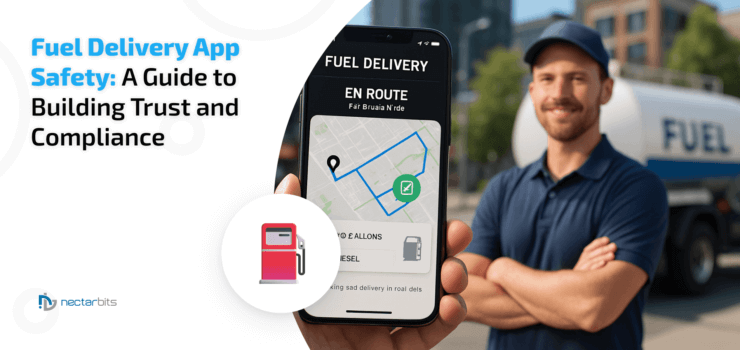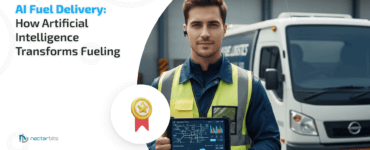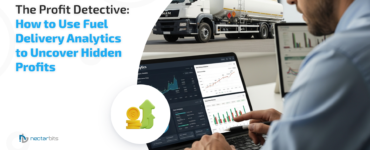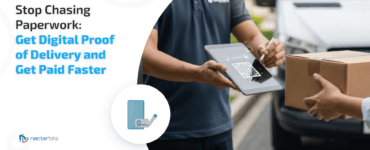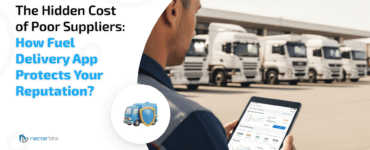Introduction
Fuel Delivery App Safety must be the foundation, not an afterthought, when an enterprise moves petrol to a driveway or a fleet’s yard. The idea of ordering fuel the way one orders dinner sounds convenient, and it is, but convenience carries a unique set of hazards. A petrol delivery app that grows quickly without a serious safety plan will face regulatory pain, high insurance costs, and a public relations problem that no marketing push can fully fix.
On-demand fuel delivery is appealing because it solves logistics and time friction. For operators, though, each delivery is a live experiment with fire, metal, and people nearby. That reality shapes every business decision, how services are priced, how drivers are trained, and how the app presents itself to users. Credibility emerges when systems and behavior match the marketing claim of “safe and reliable.”
The Rise of On-Demand Services and Fuel Delivery Challenges
Urban density, shorter attention spans, and better mapping tools made petrol-to-doorstep services technically possible. Add mobile payments and a functioning last-mile network, and the model is workable. Challenges arrive where physics and people meet, fuel vapors don’t obey promotions, pipes leak, and busy streets complicate safe stopping and transfer.
These operational constraints change the calculus of scale. A single incident in a crowded neighborhood affects dozens of potential customers, invites multiple authorities to inspect operations, and can slow expansion for months. Firms that plan for the worst tend to grow steadily; those that improvise find growth brittle.
Why Fuel Delivery App Safety Is Crucial
Safety affects three stakeholders in concrete ways. Regulators want compliance records and clear contingency plans. Insurers want to see predictable maintenance and verified training. Customers want reassurance, short service windows, and clear, plain-language instructions. When these three are satisfied, the company benefits from lower friction, fewer fines, and a healthier margin.
Safety also sets a competitive separation. A company that consistently demonstrates safe behavior gets easier entry into enterprise contracts, keeps insurance premiums manageable, and faces fewer operational interruptions. For founders and product leaders, safety is an investment in both reputation and the balance sheet.
The Non-Negotiable Core of Fuel Delivery App Safety
Handling Flammable Materials
Handling fuel requires standardized hardware and strict processes. Dispensing equipment must meet certifications for the region; no aftermarket or improvised hoses. Transfers should use bonding and grounding where needed, controlled flow rates, and fail-safe cutoffs. Written checklists in the vehicle and in the app that drivers consult before every job reduce guesswork.
Small steps matter, an accurately calibrated flow meter records exact volumes; labeled nozzles reduce operator confusion; double verification for transfers above a threshold removes single-point human error. Those details add minutes but also cut surface area for accidents.
Physical Safety Protocols
Safety equipment is often overlooked but essential. Each vehicle should carry wheel chocks, spill kits, fire blankets, and a compact emergency manual. Drivers should be trained to assess the site before starting. Is the vehicle stable? Is there an enclosed space nearby? Will the spill route endanger others?
Stopping rules, for example, no refueling in enclosed garages or during heavy storms, must be absolute. Enforcement is easier when policies are simple and communicated clearly to both staff and customers through the app.
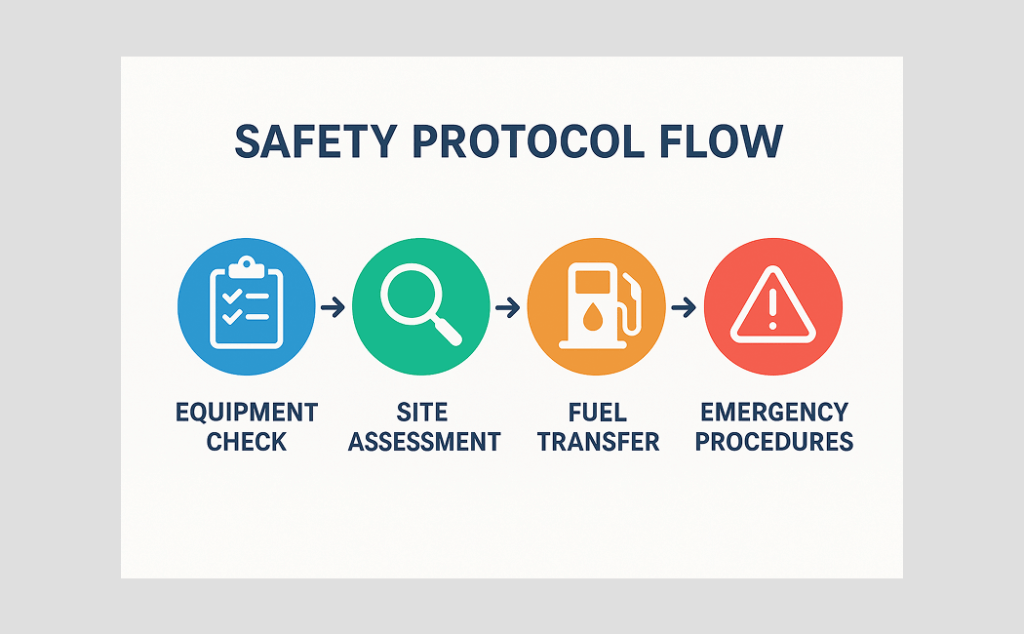
Navigating the Regulatory Landscape
Federal and State Regulations
Fuel movement crosses multiple jurisdictional lines. Federal guidelines typically establish baseline HazMat expectations; state laws add licensing, reporting, and waste disposal requirements. Before expansion, the company should map regulations by ZIP code, assign internal owners to each set of requirements, and keep a living register of permits.
A central compliance register is not glamorous, but it prevents sudden shutdowns. When auditors come, the company that produces clear records, training certificates, maintenance logs, and incident reports looks organized and earns faster resolutions.
HazMat Compliance and Licensing
HazMat training, placarding, and documentation are not optional. Drivers must hold required endorsements; vehicles should display appropriate markings. Emergency response forms must be carried in each vehicle and stored electronically for rapid access. Insurers will review these artifacts; their willingness to write a policy and at what price depends on this paper trail.
Local Ordinances and Permits
Cities create specific constraints; certain districts may ban curbside dispensing, require timed windows, or demand local permits. Early engagement with municipal authorities during pilots reduces friction later. A company that demonstrates a willingness to cooperate and to limit operations temporarily in sensitive zones keeps its options open.
For entrepreneurs wondering how to start a fuel delivery business, operations begin with narrow, well-researched pilots, secure local permits, and scale only after proving the safety model under regulatory scrutiny.
Implementing Technology for Uncompromised Fuel Delivery App Safety
Real-Time Monitoring & GPS Tracking
Key fuel delivery app features include real-time telemetry, geofencing, and incident logging; these are the live tools managers use to see when a job deviates from expectation. Operational dashboards that show live positions, route adherence, and geofence violations are essential. Geofencing prevents refueling in restricted areas; route analytics surface risky patterns. Alerts for sudden stops, off-route detours, or unexpected loitering help managers intervene before an incident escalates.
Visibility reduces both actual risk and perceived risk among corporate clients and insurers.
IoT Sensors and Smart Valves
Sensors turn nuisance variables into actionable data. Flow meters, pressure monitors, vibration sensors, and leak detectors feed automatic shut-offs. Smart valves that close on abnormal readings prevent overfill. These devices also create an audit trail for incident analysis.
Mention of fuel delivery app development enters here because building reliable telemetry and fail-safe firmware requires close coordination between hardware engineers and software teams. Expect iterations, sensor age, calibration drifts, and operational behavior changes; the system should include routine checks and replacement cycles.
A caution sensor is only as good as its upkeep. False positives or blind spots breed complacency; maintenance must be part of policy.
Secure Payment Gateways
Safe money movement keeps the service running. PCI-compliant gateways, tokenized transactions, and robust logging integrate with delivery records to create a single auditable timeline for every job. Payment failures may seem unrelated to physical risk, but a halted account can strand drivers mid-route and complicate emergency responses.
Also, a clear transaction record helps in claims processing when a dispute arises.
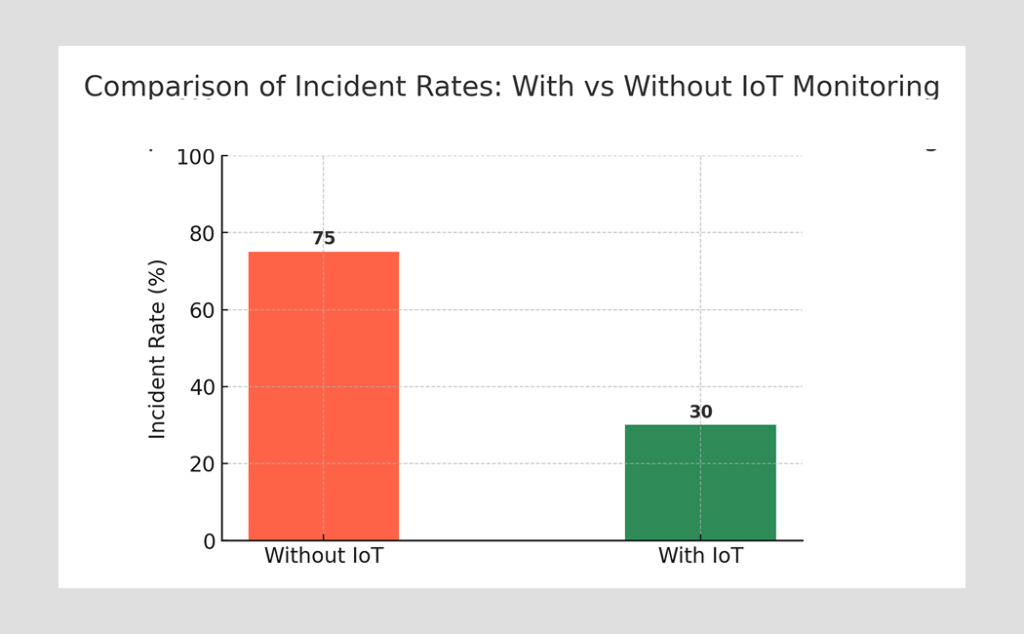
Operational Best Practices for On-Demand Fuel Delivery Compliance
Driver and Fleet Training
Training should be recurring and hands-on. Classroom learning alone does not produce rapid, correct responses in the field. Simulations, drills, forced evacuations, and rapid valve closures build reflexive behavior. Certification renewals and ride-alongs allow supervisors to see whether training translates to practice.
Training content should explicitly include fuel delivery safety protocols, customer interaction under stress, and route assessment skills. Good programs balance competence with humility. No single checklist covers every scenario.
Maintenance and Inspections
Daily pre-shift checks and weekly inspections for dispensers, hoses, valves, and vehicle mounts are minimums. Log everything. Maintenance histories reduce insurer skepticism and create a pattern of care that regulators respect. Predictive maintenance, powered by telemetry, reduces surprise failures and keeps vehicles available.
Emergency Protocols
A layered emergency plan reduces response time. First, secure people and isolate the hazard. Second, contain the spread with spill kits and controlled shutoffs. Third, escalate to the company control center and local authorities. Each driver should carry a laminated emergency card and a single number to call for escalation.
Exercises that involve local fire departments and municipal responders build trust and improve outcomes.
Building a Culture of Trust with Transparency
Communicating Safety to Users
An On-Demand fuel delivery app solution should tell customers plainly what will happen during the refill steps the driver will take, simple precautions the customer can observe, and how to report a problem. Customers prefer clarity. Short, plain-language app prompts about what the driver will do, how long the process takes, and what a customer should do in an emergency reduce confusion. Brief safety videos and FAQ links in the app create a visible safety promise.
Incident reporting should be simple. A transparent report-and-respond mechanism followed by public summaries of corrective steps demonstrates seriousness in a way marketing claims cannot.
One mention of a fuel delivery solution in marketing or enterprise collateral is adequate; the operational evidence has to back it up.
Certifications and Industry Partnerships
Third-party audits, accredited training partners, and insurer endorsements matter commercially. They signal that processes have been vetted. Partnerships with municipal bodies or emergency services during pilots show intent to cooperate rather than to dodge responsibility.
For enterprise clients, a portfolio of certifications and regular audit cycles is often a precondition for contracts.
Conclusion
Scaling an on-demand fuel service requires humility. The technology is one part; the human systems that maintain and enforce safe behavior are another. The sensible path is an incremental pilot with strict controls, gather data, refine processes, and only then widen the footprint.
Leaders who prioritize repeatable practices, clear records, and honest communication build trust. That trust becomes the reason a fleet manager feels comfortable signing a yearly contract, why insurers offer better terms, and why a neighborhood will accept the service in the first place. Fuel Delivery App Safety is not an add-on; it is the product.

Frequently Asked Questions
You’ll need federal HazMat compliance, state-specific fuel handling licenses, local permits for your operating areas, and proper vehicle certifications. Requirements vary by location, so we recommend mapping regulations by ZIP code before development begins.
A fully compliant fuel delivery app typically takes 6-12 months to develop, including safety features, IoT integration, real-time monitoring, and regulatory compliance systems. Timeline depends on complexity and required certifications.
Essential features include real-time GPS tracking, geofencing to prevent restricted area deliveries, IoT sensor integration, automated shut-off systems, emergency protocols, driver training modules, and comprehensive incident reporting.
Yes, we specialize in integrating hardware like flow meters, pressure monitors, leak detectors, and smart valves with mobile apps. This creates automated safety responses and provides real-time operational data for better risk management.
We build apps with built-in compliance features, including audit trails, maintenance logging, training certification tracking, and automated reporting. Our development process includes regulatory consultation to ensure your app meets all industry standards from day one.


